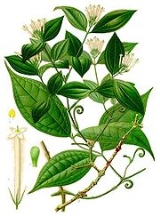
Curare
Overview
South America
South America is a continent situated in the Western Hemisphere, mostly in the Southern Hemisphere, with a relatively small portion in the Northern Hemisphere. The continent is also considered a subcontinent of the Americas. It is bordered on the west by the Pacific Ocean and on the north and east...
. The three main types of curare are:
- tubocurareTubocurarineTubocurarine is a neuromuscular-blocking drug or skeletal muscle relaxant in the category of non-depolarizing neuromuscular-blocking drugs, used adjunctively in anesthesia to provide skeletal muscle relaxation during surgery or mechanical ventilation...
(also known as tube or bamboo curare, because of its packing into hollow bamboo tubes; main toxin is D-tubocurarine). It is a mono-quaternary alkaloidAlkaloidAlkaloids are a group of naturally occurring chemical compounds that contain mostly basic nitrogen atoms. This group also includes some related compounds with neutral and even weakly acidic properties. Also some synthetic compounds of similar structure are attributed to alkaloids...
, an isoquinolineIsoquinolineIsoquinoline is a heterocyclic aromatic organic compound. It is a structural isomer of quinoline. Isoquinoline and quinoline are benzopyridines, which are composed of a benzene ring fused to a pyridine ring. In a broader sense, the term isoquinoline is used to make reference to isoquinoline...
derivative. - calebas curare (also called "gourd curare" by older British classifications, being packed into hollow gourds; main toxins are alloferine and toxiferineToxiferineToxiferine is a curare toxin. It is a nicotinic acetylcholine receptor antagonist....
) - pot curare (packed in terra cottaTerra cottaTerracotta, Terra cotta or Terra-cotta is a clay-based unglazed ceramic, although the term can also be applied to glazed ceramics where the fired body is porous and red in color...
pots; main toxins are protocurarine, protocurine, and protocuridine).
Of these three types, some formulas belonging to the calebas curare are the most toxic, relative to their values.
Curare has been used historically as a paralyzing poison by South American indigenous people.
Unanswered Questions

